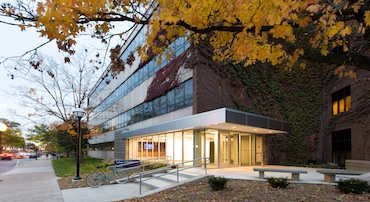Pharmacy Students Educate Public on Safe Opioid Use and Disposal

With overdose deaths in Michigan from opioids jumping 54 percent between 2015 and 2016, and more than tripling since 2012, University of Michigan students were out in the community Tuesday, Aug. 29, to help those with prescriptions understand the risks of their medications.
Roughly 70 teams of students from UM's College of Pharmacy were stationed at 35 different community pharmacies in Washtenaw County to talk to customers about safe opioid use and disposal, recognizing abuse and how to connect to local resources for help. Students occupied a booth at pharmacies providing information about opioids at these locations.
With 1,275 people in Michigan dying from opioid overdoses in 2015, proper education about that use is essential for both patients and future pharmacists, first-year pharmacy student Raul Ghib said.
"Statistics show that 1.9 million Americans are addicted to (opioids) so it's good to be aware of this issue," said Ghib, who was visiting the Rite Aid on Plymouth Road in Ann Arbor. "Obviously different administrations of opioids can lead to fatal situations. It's good to know what you are taking, how it should be taken and the requirements that come with a drug, including how you should store it and how you should guard it from other members of the family."
Opioids are a class of drugs that include the illegal drug heroin, synthetic opioids such as fentanyl and prescription pain relievers such as OxyContin, Vicodin and codeine. Michigan health-care providers wrote 11 million prescriptions for opioid drugs in 2015 and another 11 million in 2016.
Opioids can be highly addictive, and their use and abuse is a growing issue in the United States. While the U.S. has about 5 percent of the world's population, it consumes about 80 percent of the global supply of prescription opioids.
 Despite the risk for addiction, pharmacy student Winston Kirtley said there is an important distinction between opioid dependence and addiction that pharmacists must point out to those who use prescription medications.
Despite the risk for addiction, pharmacy student Winston Kirtley said there is an important distinction between opioid dependence and addiction that pharmacists must point out to those who use prescription medications.
"(There's an assumption that) because I'm dependent on a drug or withdrawing from it, that I'm becoming an addict," Kirtley said. "Or if they are concerned about how much of the drug they're taking or feel they need to take more of it, they believe they're addicted - but that's not addiction. Addiction is when you can't control yourself and you need the drug and you're giving up your daily activities just for the drug. People shy away from (opioids) because they don't want to be seen as an addict."
Educating students about how they communicate with customers is becoming more and more prevalent in the school's curriculum, College of Pharmacy Dean James Dalton said.
Hosting an event like Tuesday's opioid education day for the first time, Dalton said, is the next step in helping them with the socialization elements of pharmacy.
"Our goal is to make sure our students are socialized in terms of communicating with the public. As technology advances, some of these jobs behind the counter are going to become less and less for pharmacists, with robotics dispensing prescriptions," Dalton said. "We see the pharmacist as an educator for patients and the community, in helping them understand their medications and the risks of those medications."



